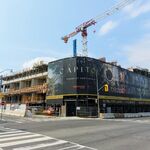ADRM, I agree that funding is the million dollar question, and one that will have to be answered whether burial or the hybrid option goes ahead. Presumably a portion of the financing would come from the ‘tax incremental financing’ of developing along the new artery, but only a portion. That’s why Wynne has been floating HOT toll lanes along Toronto highways. I think a tolled Gardiner tunnel would fine as long as there are viable exits from the Gardiner to the surface road network at the eastern and western ends of it, i.e. west of Bathurst and at the Unilever site or just west of the DVP. The Gardiner toll tunnel would be mainly for thru traffic, drivers who are not entering the core or who are willing to pay for a quick exit from it.
I’m not sure what this would look like at the eastern end, though there is no shortage of land at places like the Unilever site. At the western end it’s really the Front Street extension and section of land west and north of Fort York (including some of the rail corridor west of Bathurst?). How would we pay for these ramps and Front Street extension? That’s where I think a north-south toll tunnel (Allen Expressway?) comes in. It would pay for those on/off ramps for the western Gardiner. I’d recommend tolling the north-south tunnel until this offloading infrastructure is paid for (10-15 years?), then only remove the tolls on the stretch from Richmond south to the Gardiner, at which point we can seriously look at removing the elevated Gardiner, because there would be multiple exits from the western Gardiner, discretely tunneled and free to motorists. It’s essential also that at both the eastern and western ends of the Gardiner tunnel there are efficient means of transferring from autos to transit, so intermodal stations (with parking, perhaps multi-level and underground?) at Bathurst and Unilever are key. All of this infrastructure would need to be in place to begin construction of the tunnel. Of course, the cheapest option is removal of the Gardiner without tunneling any of it, but you still need a means of offloading traffic to the road network, which is what this proposal makes possible.
With regard to your question of which lands are available for development along the Gardiner, I would agree that land only becomes available east of Yonge with a reconfiguration of Lakeshore AND the Gardiner's path, such that the Gardiner tunnel runs underneath Lakeshore and its adjacent lands. There would likely be no exits east of Yonge and west of the DVP, and there would be a construction shut down of both Lakeshore and the elevated Gardiner (full removal of the elevated Gardiner) east of Yonge to reconfigure Lakeshore. Then there would indeed be enough room on both sides of Lakeshore above the tunnel/ditch for development, especially approaching Cherry St. and the Keating Channel.








